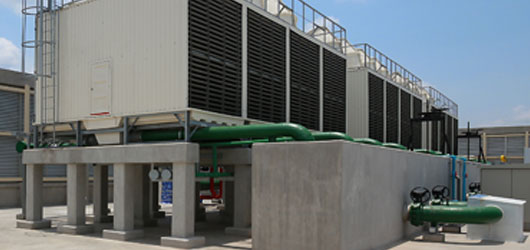Regulated Water Systems - Cooling Towers and Warm Water Systems

Regulated Water Systems must be managed safely in order to prevent the growth and transmission of Legionella bacteria. Infection may cause Legionnaires’ disease, a serious and potentially life-threatening condition. The Public Health Act 2010 and Public Health Regulation 2022 define the roles and responsibilities for managing cooling towers and other regulated systems.
Management of Regulated Water Systems
Under the Public Health Regulation 2022 building owners and occupiers of premises that contain a water cooling system must ensure that:
- A competent person (defined in Public Health Regulation 2022 ) must undertake a risk assessment of the cooling water system and document it in a risk management plan (RMP), at least every 5 years (more frequently for higher risk systems).
- A competent person prepares a certificate confirming the RMP has been completed. The RMP must be submitted to the Council within 7 days of completing the risk assessment.
- Compliance with the risk management plan and Public Health Regulation 2022 must be independently audited and documented in an audit certificate. The certificate must be submitted to the Council every year.
- Monthly sampling and testing of the system for Legionella and heterotrophic colony count must be undertaken.
- High test results for Legionella (≥1000 cfu/mL) and heterotrophic colony count (≥5,000,000 cfu/mL) must be reported to the Council within 24 hours of receiving the results.
- Unique identification numbers for cooling towers must be displayed on all cooling towers. The Council allocates the unique identification numbers.
Please contact Hornsby Shire Council on 9847 6666 to report a high legionella count or high heterotrophic colony count and complete the notification form.
Risk Management Plans (RMP), Audit Reports and Reportable Test Results
Since August 2018 NSW Health has required their approved forms be used for the submission of risk management plans, audit reports and reportable test results for cooling water systems. NSW Health also requires these forms, upon completion, be lodged with Council.
Download the NSW Health approved forms
The owner/occupier of a premises where a regulated water system is installed must also:
- Register their system with Hornsby Shire Council using the Regulated System Notification Form and pay the registration fee
- Any changes to the owner, the occupier, emergency contact and changes to the regulated system must be notified to Council via the regulated system notification form
- Install, operate and maintain the systems and records in accordance with the Public Health Act 2010, Public Health Regulation 2022, Public Health Amendment (Legionella Control) Regulation 2018 and Australian Standard 3666 series.
What are Council’s responsibilities?
Local councils are required to maintain an accurate register of cooling towers and warm-water systems installed on premises in their area.
Council must provide unique identification numbers for individual cooling towers when a notification form for a new cooling tower is received and are responsible for receiving and maintaining cooling tower documentation.
The occupier of a cooling tower must submit certificates of risk management completion, cooling tower audit reports, notification of high levels of legionella and heterotrophic colony count and taking appropriate action The occupier of a cooling tower will be charged an annual administration fee.
Environmental Health Officers may conduct an audit of warm water systems and cooling towers to ensure the maintenance of systems comply with the Public Health Act 2010 and the Public Health Regulation 2022.
If an outbreak occurs, the Legionnaires’ Disease Emergency Management Plan prepared by the NSW Health Department will be put into action.
For practical guidance on the legal requirements relating to legionella control in cooling water systems, please refer to the NSW Guidelines for Legionella Control in Cooling Water Systems found on the NSW Health website.







